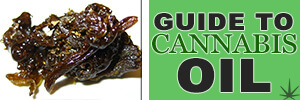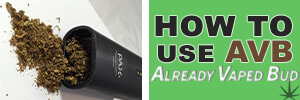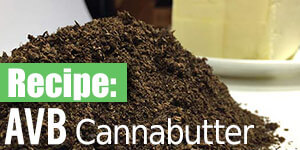There is quite a bit of confusion about cannabis oil, in the media usually it’s just used as a blanket term for the different oils listed below. Some of which are potent extracts and others are nutritional supplements.
It’s important to understand the differences between the types of cannabis oil. Some have powerful psychoactive effects, others have none. Some types of cannabis oil are used in cooking or candle making, others are used to help treat serious medical conditions.
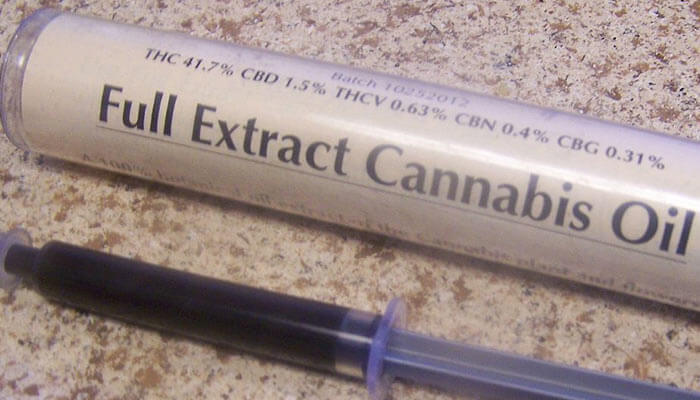
Understanding Cannabis Oil Types and Uses
Here is the complete list of the different types of cannabis oil, how they’re made and what they’re used for.
Cannabis Oil
It’s basically just cannabis butter, except with oil…
Cannabis oil can have a light to dark green or brown color and is quite aromatic. Often cannabis oil has a vegetal and nutty taste, depending on the strain and oil used.
Full flavor and full power, cannabis oil contains the psychoactive THC extracted from the bud as well as the other useful cannabinoids used for a wide number of medical conditions.
How It’s Made
Cannabis oil is really easy to make, all you need is the cannabis and some patience.
We recommend using a high quality extra virgin olive oil or coconut oil to serve as the base. Canola and vegetable oil would also work, but why sully your end product?
Cannabis Oil Ingredients:
- 2 cups EV Olive Oil
- ¼ -½ ounce Finely Ground Buds
Simmer the oil and bud on low heat for 30-40 minutes. Try to keep the temperature around 200 degrees F, never above 300!
Why It’s Used
Cannabis oil can be used in cooking if you’re looking for an added buzz at dinnertime or a healing salve to use on your skin.
Once the cannabinoids are activated during the cooking process the cannabis oil can be consumed, used topically or sublingually. Many people use cannabis oil to help treat a variety of skin conditions due to its anti-inflammatory properties. It is also useful to curb chronic pain, depression and anxiety.
Consuming cannabis oil is very different than smoking marijuana. The effects are delayed, so it’s more difficult to dial in your desired dose, especially with home-made oil that isn’t tested for potency. The rule of thumb for edibles is to go low, and go slow to start.
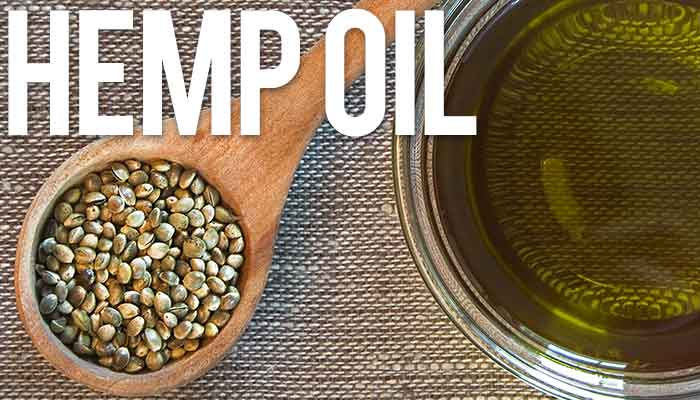
Hemp Oil
Obtained by pressing hemp seeds and extracting the oil. Cold pressed hempseed oil is green in color and has a nutty flavor. Refined hemp oil is colorless, tasteless and void of any vitamins or antioxidants.
Hemp oil doesn’t contain any THC. Seeds are cleaned thoroughly before the oil is pressed, however trace amounts of THC can usually be found in hemp oil.
How It’s Made
Raw hemp seeds are subject to extreme pressure to extract the oil. In order to be considered cold-pressed, the seeds and oil mustn’t reach 120 degrees F or higher.
These oils aren’t generally produced at home.
Why It’s Used
Hemp oil is used in a number of beauty and body care products.
Industrial applications of hemp seed oil include being used in lubricants, paints, fuel and plastics.
The nutritional value of unrefined cold-pressed hemp oil is enormous. It contains a 3:1 ratio of Omega-6 to Omega-3 essential fatty acids, essential for our cellular health.
Hemp oil has a very low smoke point, so it isn’t an ideal cooking oil. It is used in a number of no-cook dishes though, and it can also be found in certain dietary supplements.
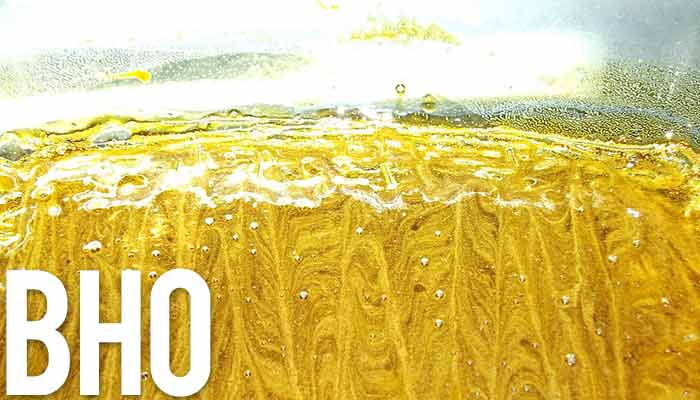
Butane Hash Oil (BHO)
If you have enjoyed extracts before, chances are you have tried Butane Hash Oil (BHO). Butane hash oil is pretty popular because it is pretty simple to make and hits hard AF!
BHO falls into the category of solvent oil, similar to CO2 oil and oil made with alcohol. It’s usually a light amber color and is quite sticky to the touch. Butane hash oil is also commonly known as Honey Oil.
*Butane is extremely flammable and has hazardous fumes. Make BHO in a very well ventilated area and away from any sparks, flames or red hot elements.
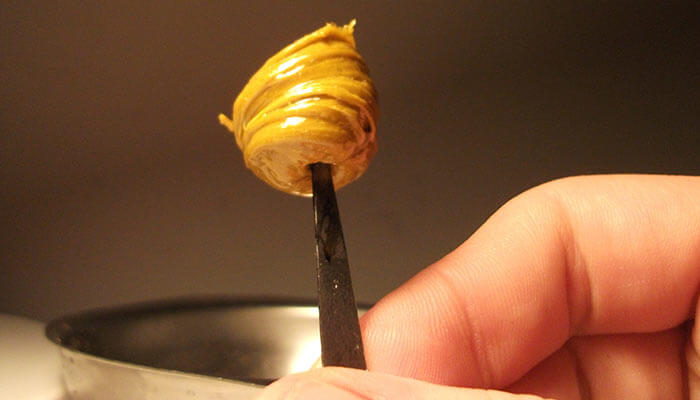
How It’s Made
Butane hash oil is also pretty simple to make once you have the equipment. The process just involves exposing the finely ground bud to butane and gathering what drips to the bottom.
- 1 can of Butane
- ½ oz. finely ground Bud
- Extractor (see below)
- Glass dish
A common do-it-yourself extractor can be sourced from any hardware store. A short length of Copper Tubing (8-12 inches) and a couple of caps are all you need. Some folks use PVC, but the butane can cause some seriously harmful toxins to leech out of the plastic. There are glass extraction devices that you can buy too, easily your best option if you have the cash.
Drill one small hole in one cap for the butane spigot to go. It should fit snugly.
Drill a few smaller holes in the other cap, this is where the oil will gather and drip out.
Fill the pipe with you ground bud and secure the caps. (Don’t secure caps with glue, press fit or bust!)
Over the glass dish, empty the butane can into the copper pipe. The pipe should be vertical, allowing gravity to do its job and help the oil find the bottom of your glass dish.
Let everything sit for a while so you can be sure you get every last drop.
Once the oil is gathered in the dish, you will need to heat it slightly to boil off the excess butane. You can hold the dish in your hands, usually this will give off enough heat to start boiling the butane off. Otherwise you can put the dish in a small bath of warm water. Keep it away from open flame.
Once the bubbling stops and you are confident all the butane is boiled off, scrape up the gooey mess on the bottom of the glass dish. You have yourself some homemade butane hash oil!
Why It’s Used
BHO is a concentrated form of cannabis, giving users a potent high with a few short puffs.
Butane hash oil is used for the same reasons medical marijuana is used, it provides the same pain relieving, mood lifting and stress reducing properties.
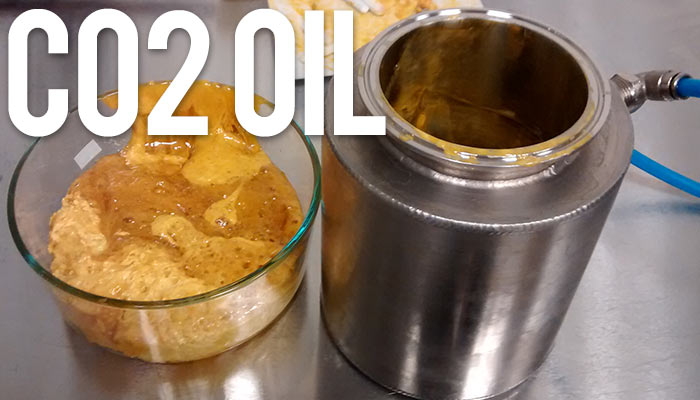
CO2 Oil
Here is where producing cannabis oil turns into an art form. Oil produced through CO2 extraction is the purest oil you can get at the moment. More of the terpenes and cannabinoids remain in tact, giving users a full-flavor, full-potency oil that can be smoked, vaporized or consumed orally.
CO2 is the preferred extraction method because it is considered a green solvent, unlike petroleum derived solvents like butane.
How It’s Made
CO2 isn’t something you will be able to make at home. Making CO2 oil requires some specialized equipment and some serious know-how, leave it to the experts.
But let’s discuss a few key points in the CO2 oil making process.
- Carbon dioxide gas has a critical point of 90 degrees F. This is cool enough to extract the fragile terpenes and cannabinoids without deactivating them.
- Different pressures allow for different components of the plant to dissolve. CO2 extractors are capable of separating the terpenes and cannabinoids from each other completely.
- Carbon dioxide oil extracts can yield 10% terpene mass. Compared to around 3% terpene mass for most butane hash oils (BHO).
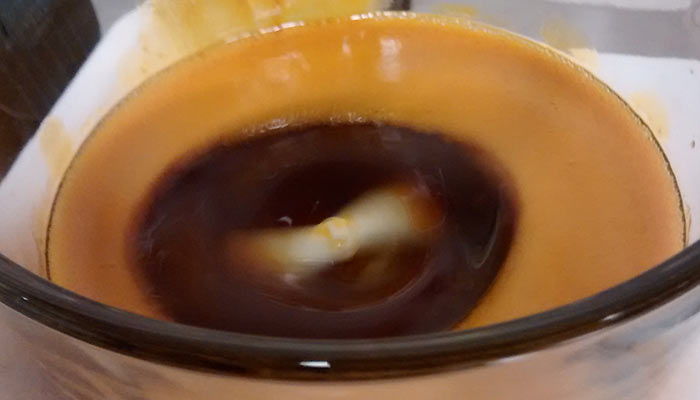
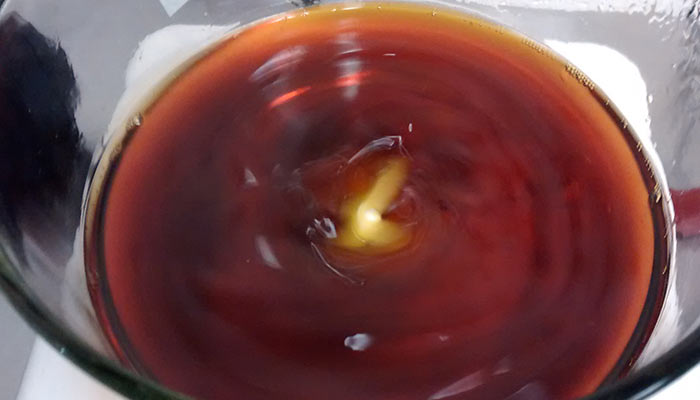
Why It’s Used
CO2 oil is used for just about everything. Because extraction artists can dial in on the desired component of the cannabis plant, they are able to make oils with high THC levels, or none at all. Medical patients interested in the pain relieving components of cannabis can purchase CO2 oil with none of the psychoactive effects but all of the medical benefits they are interested in.
Oil produced through carbon dioxide extraction is less viscous than BHO, while it can be smoked, it is usually vaporized.
CO2 Oil pics via /u/kyle_kyleson on /r/trees.
Rick Simpson Oil (RSO) / Phoenix Tears
Rick Simpson Oil is named for the man who treated his skin cancer using this natural remedy back in 2003, his name… Rick Simpson.
RSO or Phoenix Tears are generally dark amber in color, a tar-like oil that is extremely sticky to the touch.
How It’s Made
Rick Simpson Oil is pretty simple to make, you just need some cannabis and some isopropyl alcohol. Soaking the cannabis leaves, buds and stems in the alcohol will draw out all of the beneficial compounds, leaving you with a supremely potent oil.
- 1 ounce Dried Cannabis
- 500 ml Isopropyl Alcohol
- 2 Buckets
*While RSO / Phoenix Tears are relatively simple to make, it is very important you take the necessary precautions when working with a solvent. Isopropyl fumes are extremely flammable, be sure to keep the RSO away from any flames, red hot elements or cigarette embers. Also be sure to boil off the solvent in a well ventilated area to carry the fumes away immediately.
Take 1 of the plastic buckets and add your dried herb, crush it up with a spoon or whatever you have to stir the mixture around (don’t use treated wood or anything with a finish that could dissolve in the mixture).
As you crush up the herb in the bottom of the bucket, slowly pour in your solvent. Use about ⅔ of the isopropyl alcohol during the first wash, making sure the bud is completely submerged and you are stirring it constantly (3-5 minutes should do).
Pour the liquid into your second bucket. Do your best to leave any of the plant material in the first bucket, it’s needed for the second wash.
Now take the rest of the alcohol and pour it over your plant material. Mix it thoroughly for another couple of minutes.
Pour the liquid into the second bucket.
Take the liquid mixture and pour it through a coffee filter into a clean glass jar or container. This will remove any extra particles that you may have let slip when transferring the liquid.
Use a rice cooker to boil off the alcohol. Be sure not to overfill the rice cooker if you are doing a larger batch of oil.
Set the rice cooker to high (never let the mixture get to 290 degrees F or higher).
Add a few drops of water as the mixture is boiling off the alcohol (1-2 drops for 1 ounce should be fine). This will help release any residue and help keep the oil from overheating.
Once the alcohol is boiled off and you have a more concentrated mixture, take it off the rice cooker and give it a swirl. Then pour it into a stainless steel container and put it on tray warmer or something similar.
Sit back and let the last of the water and alcohol evaporate. Once the top of the mixture is calm it’s ready.
Transfer your Rick Simpson oil into an air-tight container or syringe.
Why It’s Used
RSO / Phoenix Tears can be used either orally or topically. Because it ranges so widely in THC / CBD content depending on the strain used, different oils can have different recommended uses. There are also quite a few oils on the market that include other healing herbs or ingredients, RSO variants are seemingly endless.
Rick Simpson, the namesake of RSO, made it famous by using it to treat his skin cancer in 2003. On his website phoenixtears.ca he says RSO is useful to “cure or control cancer, MS, pain, diabetes, arthritis, asthma, infections, inflammation, blood pressure, depression, sleeping problems and just about any other medical issues that one can imagine.”
Rick Simpson also states that THC levels can be in the 90% range. However there are many cannabis strains that contain very little THC, so there are as many varieties of RSO as cannabis itself.
Cannabidiol Oil (CBD Oil)
CBD oil is another blanket term, characterizing any oil where cannabidiol is the primary active ingredient. Cannabidiol oils don’t contain THC in any meaningful amount, they are made with high CBD marijuana strains to ensure optimal yield.
How It’s Made
Because CBD oil is just a term used for extracts high in CBD, it can be made a few different ways.
Oil: Just like the cannabis oil above we discussed above, CBD oil can be made by simmering high CBD buds with a quality oil.
CO2: Again, the purest and best way to produce any extract. CO2 CBD oil will contain the fewest impurities and can provide a more regulated dose.
Solvent: A popular do-it-yourself way to produce CBD oil. Solvent extraction will also dissolve other cannabinoids, giving you the full potency of the plant. This makes it very important to use cannabis strains with high CBD content and very little THC.
Why It’s Used
Cannabidiol doesn’t have any psychoactive effects, it does however have profound healing effects and medical benefits. CBD is a powerful anti-inflammatory, antioxidant, anti-cancer and anti-tumor cannabinoid. It is a potent pain reliever that doesn’t just mask the pain, it helps relieve the chronic inflammation that prevents the body from healing.
Having no psychoactive effects makes CBD a perfect option for many medical users and children. Using a CBD oil allows users to get an exact dose and ingest it orally, making it very similar to other liposomal health supplements. It’s helping end the stigma attached to medical marijuana by giving people a more clinical experience, without the laundry list of side effects.
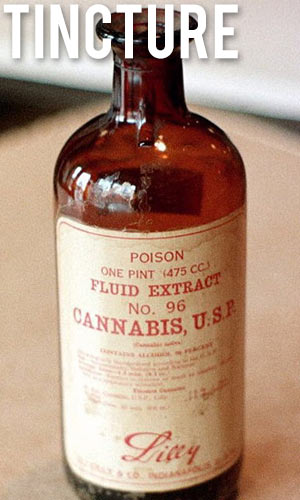 Tinctures
Tinctures
Believe it or not, tinctures were the most commonly used form of medical marijuana in the United States before prohibition in 1937.
Tinctures are a liquid concentrate, unlike some of the other cannabis oils discussed tinctures aren’t viscous at all. A dose consists of a few drops placed under the tongue, the tincture is then absorbed directly into the bloodstream.
How It’s Made
Tinctures are produced through alcohol extraction, allowing decarboxylated cannabis to sit and steep in the alcohol extracts the cannabinoids into the liquid.
- 1 ounce Cannabis Buds
- 1 pint Vodka
Grind the cannabis buds finely, but not into a powder.
Place the ground buds into a 240 degree F oven for 30-60 minutes to decarb it (activates the cannabinoids).
Let the cannabis buds cool to room temperature then place the herb in a large mason jar with the vodka. Seal it shut.
Give the jar a vigorous shake and put it into the freezer for a week.
Be sure to give the jar a good shake once or twice every day to stir things up and ensure optimum extraction.
After a week, take the jar out of the freezer and pour the contents through cheesecloth or a coffee filter to remove any plant matter.
Keep cannabis tincture in air-tight, light proof containers and store them in a cool location.
Why It’s Used
Cannabis tinctures are used for a variety of ailments and praised for their ease of use. A few drops from a plain old eye-dropped under the tongue delivers the full benefit of the cannabis tincture.
Medical marijuana patients often use cannabis tinctures to aid in the treatment of chemotherapy side effects: nausea, pain, anxiety, depression and loss of appetite.
The range of tincture benefits is massive, users report success with back pain, stress, seizures, tremors and arthritis, to name a few.
Tinctures come in all sorts of different flavors and blends, targeting specific ailments with a range of herbal essential oils.
Also check out:
resources: thestonerscookbook.com, wikipedia.org, leafly.com, collective-evolution.com, cannabis.info and hightimes.com






